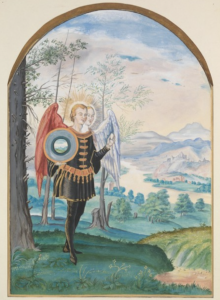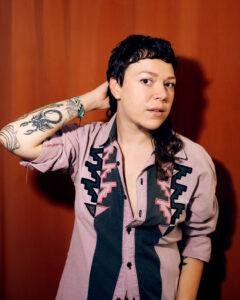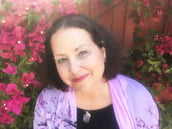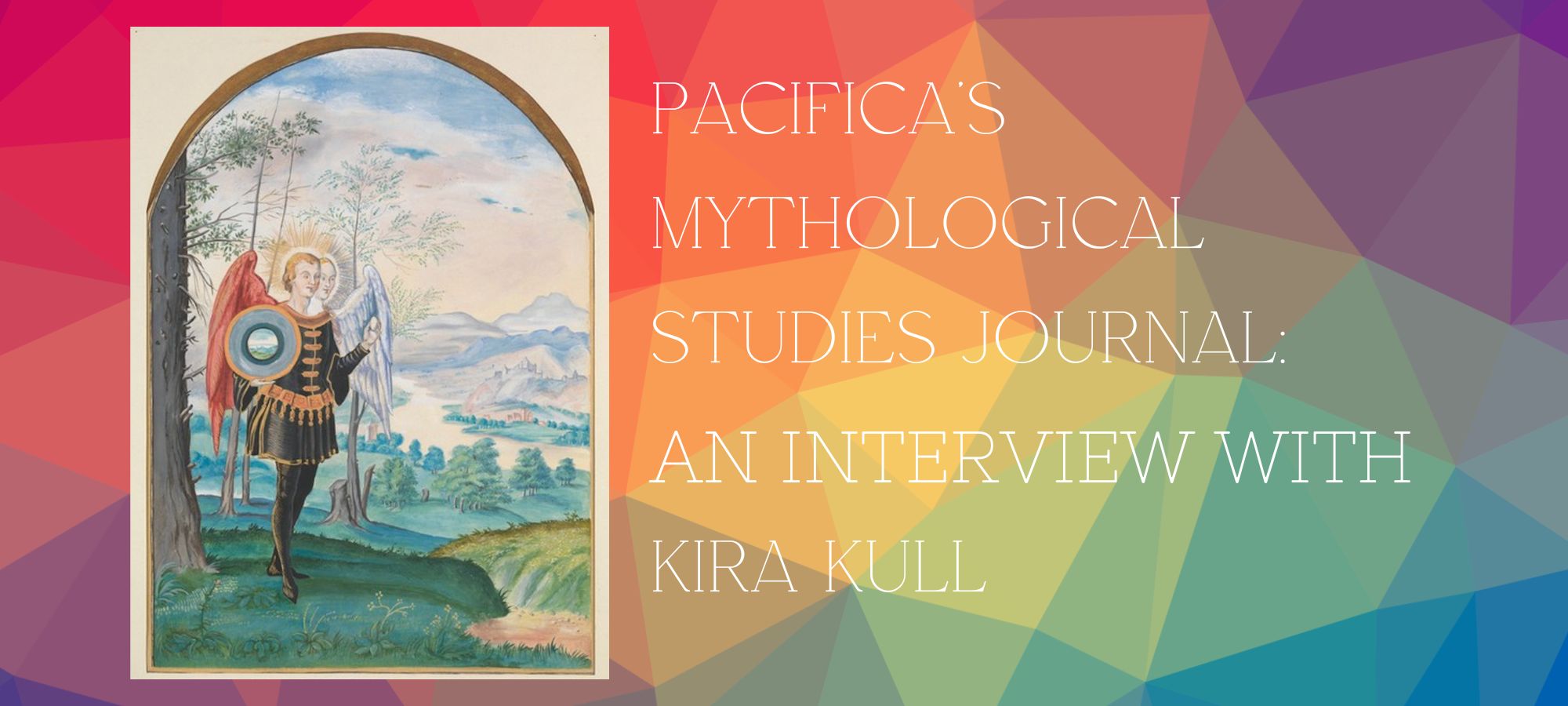Kira Kull is a student in the MA/PhD Mythological Studies Program with a specialization in Depth Psychology, as well as being the Co-Senior-Editor of the 2023 Mythological Studies Journal (Volume XI), which is now available to read online and print! MSJ is entirely student run and edited, featuring pieces by students enrolled in the MA/PhD Mythological Studies Program. You can read this issue now here. Or purchase it here.
Angela: You currently list your interests as “Intersex Studies, Queer Myths and Theory, Ancient Goddess Traditions, Sacred Psychedelia, Jungian and Archetypal Psychology, and Pop-Cultural Studies.” Recently you were a consulting mythologist on Butch Visions, “a facilitation and solo performance that wrestles with generational queer wounds.” And you also contributed writing to Wussy, Volume 11, “Bringing Intersexy Back.” How much has your time at Pacifica in the Mythological Studies program influenced your work and interests, or were these already in place before you came here?
 Kira: A bit of both. I have always been interested in ancient mythology and given my background in theater and storytelling, I’ve witnessed a lot of the ways that ancient myths continue to impact our modern stories. So I came in with that interest, and I was curious to start looking into how queerness and the queer body and intersex people have been portrayed in myth throughout human history. I didn’t have a lot of reference points coming into Pacifica for queer people in antiquity. I’m lucky that I see a lot of that representation in my own friend groups, and we are beginning to see more in pop culture and mainstream media, but when I started the Myth program, I began to deeply feel and realize the impact of not seeing yet how queer people, and especially gender expansive people, have fit into the past. So that has become more of a focus than I expected it to. Part of that is looking at ancient goddess traditions. A personal interest in that actually led me to this program, seeking to re-cultivate what an ancient female or feminine deity might look like compared to the beauty standards of today.
Kira: A bit of both. I have always been interested in ancient mythology and given my background in theater and storytelling, I’ve witnessed a lot of the ways that ancient myths continue to impact our modern stories. So I came in with that interest, and I was curious to start looking into how queerness and the queer body and intersex people have been portrayed in myth throughout human history. I didn’t have a lot of reference points coming into Pacifica for queer people in antiquity. I’m lucky that I see a lot of that representation in my own friend groups, and we are beginning to see more in pop culture and mainstream media, but when I started the Myth program, I began to deeply feel and realize the impact of not seeing yet how queer people, and especially gender expansive people, have fit into the past. So that has become more of a focus than I expected it to. Part of that is looking at ancient goddess traditions. A personal interest in that actually led me to this program, seeking to re-cultivate what an ancient female or feminine deity might look like compared to the beauty standards of today.
Angela: What attracted you to the Mythological Studies Program? Do you already know what your dissertation will be on?
Kira: I have my dissertation formulation coming up in spring, but it’s likely to center around intersex figures, and the umbrella of transgender, nonbinary, and other gender-expansive identities that might have been misidentified or misunderstood by non-queer scholars in the past, especially because intersex wasn’t a term being used by classical scholars until very recently. So looking at ancient and indigenous instances of androgynous, duel-sexed, and hermaphroditic figures in myth and sifting through the layers of heteronormative language and translation to see through the modern lens of queer lineage and theory to ask: what significance did these figures (and queerness by extension) hold in their cultures and how has that reception impacted our current cultural reception of queerness? I’m at an exciting point in my professional life where I feel I’ve been undergoing a career shift, partially instigated by the pandemic when I learned that I’m intersex and started to live in my natural body. I was a teacher, performer, and director in theater, and now I’m teaching in more spiritual spaces, falling in love with research and writing, and cultivating this work of consulting as a mythologist and LGBTQIA+ consultant for theater, film, and tv. So in some ways, myth and queer culture have always been the throughlines.
Angela: What attracted you to be the co-editor of the Mythological Studies Journal and what kind of material does the current volume have? How does it reflect the interdisciplinary approach of the program?
Kira: I love to support community whenever I can and a big part of why I wanted to do it was to help my fellow students share what they’re doing in the program. We’re writing three papers a term that rarely see the light of day, so the journal seemed a perfect way to present some of those pieces while also getting a feel for the work of cultivating academic storytelling via the investigations of my colleagues. Like our coursework, the edition is far reaching. We chose not to have a theme now, for the third year in the row. Part of that was to invite the chance to showcase the diversity that’s present within the program. We study wide-ranging topics and have the opportunity in our papers to dive deep into niches of our own interest. So we have many pieces that connect with depth psychology and archetypal psychology, alchemy, more modern theoretical takes on classics that sometimes utilize personal experiences, for example, feminist theories, looking at modern art and social media, western medicine, etc. and tying in these frameworks for perceiving and understanding our world via the mythos of various ancient and modern cultures.
Angela: What were your favorite and least favorite parts about editing?
Kira: My unexpected favorite thing was doing the final read-through of each piece with a fine-tooth comb. There was a time when I first started this program that editing felt like the least exciting part of writing and I wanted to develop that skill. Then in this process with MSJ, I really came to love honing and sharpening with each round of developmental and line edits. Doing those final read-throughs and seeing it come together was really amazing and satisfying. The biggest challenge was finding the unique pathways for not only each piece and the specific subject material but the individual authors, and discerning how, piece-by-piece, to bring their perspective and material to life in a way that would best serve the journal and the readers. Because there’s so much diversity, each piece required a different approach.
Angela: You have an article in the journal, “Beyond the Sum of Their Parts: An Alchemical Flight Towards Freedom.” Tell me a little about the piece and does it relate to your research/dissertation in the myth program?
Kira: In short, yes. It came out of our alchemy class, which really makes it sound like we’re in magic school [laughter]. I was amazed even before that class to hear of the figure known as the alchemical hermaphrodite. As an intersex person, I was taken aback to encounter the use of this outdated term, but also to learn about the magic of this mythic figure representing the culmination of the alchemical work, associated with psychological integration and the ultimate achievement of creating a magickal elixir or the Philosopher’s Stone. Very often in texts from medieval and Renaissance Europe, we see these hermaphroditic figures depicted with wings. They look like angels, sometimes with feathered wings, sometimes bat wings. I got interested in what the specifically winged symbol meant. I was curious why they were winged and what the different kinds of wings indicated. I wanted to know if there was more to it and if there were other variations to the symbol that had been present elsewhere in art and literature.
I came across a piece on the origin of dragons, which argues that dragons are derived from rainbows across the mythos of many different cultures and are very often androgynous or dual-sexed, integrating the meeting of opposites in gender and the elements. Thinking about dragons as this inherently queer and gender-expansive symbol was great, along with the rainbow flag being connected in modernity to the queer community, of course. I continued to weave through different aspects relating to birds, the elements, and religious philosophy that kept arising as I did research. The phoenix became a big piece of it as well, circling back to the origins of European alchemical texts, which were rooted in early Christianity. The conclusion of the piece looks at the winged hermaphrodite in connection to Christ as the Phoenix and Lucifer as the dragon, figures I was amazed to learn both have hermaphroditic historic associations. These are big ideas and I really underwent what felt like an alchemical, transformative process in the writing of this piece. Throughout my time in this program, pretty consistently, I have to stop in the middle of research and just breathe, because it’s something powerful, intangible, and big that I’m touching on that might be scary to some people and is a little scary to me. But it also might be really healing for people to learn about, especially queer people. This paper was really healing for me to write, exploring that duality and the layers of multiplicity in the winged hermaphrodite, because so much of myth orients toward finding a union between the opposites of gender, morality, nature and man, light and dark, chaos and order. Gender is just one of the most ubiquitous alleged binaries that humans tend to look at, and to talk about it through an intersex perspective, which for me is experiencing in one body the union of both masculine and feminine aspects, might help us better understand it. I think it’s essential that we explore the heritage and ancient representations of that union, and queer symbols in general, on a larger cultural scale because the symbolic winged hermaphrodite can be seen as an integrative ideal for everyone, not just trans, nonbinary, and intersex people. For genderqueer people to see the ways in which androgyny is likened to a Christ figure can be remarkably affirming. And likewise, to look at the demonization of queer people and the trans and intersex body, which we’re seeing so rampantly in US legislature today, through the likening to Lucifer makes some horrifying sense to me. It begs the question, how are we framing gender-expansive people unconsciously in our modern story-telling and what history of queer divinity has been erased, as in the case of Christ’s queerness, while the demonization of queerness linked with Satan gets amplified.
Angela: What do you most enjoy about studying at Pacifica, and the mythology program in particular?
Kira: That’s hard to answer. I love a lot! The community is really a big one, especially since my cohort started online in the fall of 2021, it’s been really beautiful and supportive now to come together on campus once a month and be able to share some of these moments of research. We do beautiful rituals together, sing together, lay on the lawn in the sunlight, exist together in community, and share our unique perspectives and areas of expertise both in the classroom and outside of it. That’s really special and not like anywhere else.
Angela: Thank you for speaking with me and best of luck with your dissertation.

Kira Kull (they/them/she) comes from an integrative background of classical and experimental theater, interfaith mysticism, and restorative justice work. With a BFA in Theatre from NYU’s Tisch School of the Arts, Kira is a Ph.D. candidate in their third year of the Mythological Studies program at PGI. An intrepid seeker of the mysteries, Kira is drawn to themes of multiplicity, repression, and resurrection offering transformative knowledge from queer and archetypal lineages as a consultant, educator, and creator. They currently live in Los Angeles and serve as Senior Co-Editor of the Mythological Studies Journal and serve as a ritual keeper for the Pacifica Myth community. For more information visit kirakull.com

Angela Borda is a writer for Pacifica Graduate Institute, as well as the editor of the Santa Barbara Literary Journal. Her work has been published in Food & Home, Peregrine, Hurricanes & Swan Songs, Delirium Corridor, Still Arts Quarterly, Danse Macabre, and is forthcoming in The Tertiary Lodger and Running Wild Anthology of Stories, Vol. 5.


